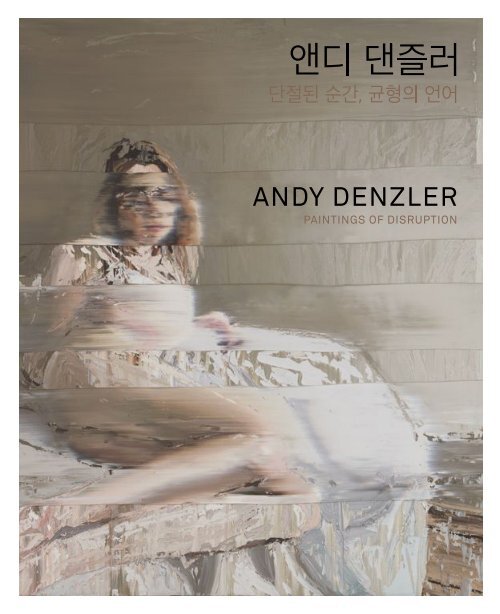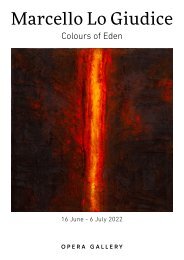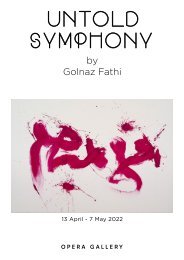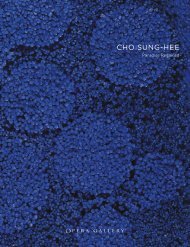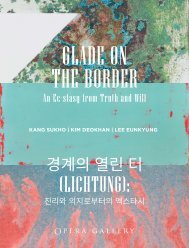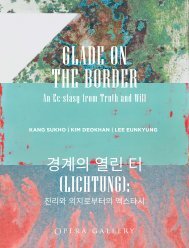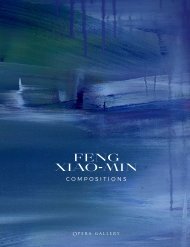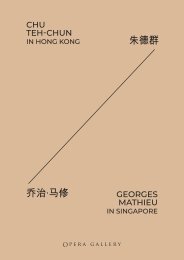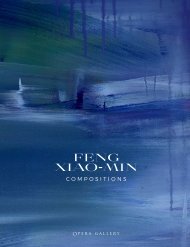ANDY DENZLER. Paintings of Disruption
ANDY DENZLER. Paintings of Disruption Opera Gallery Seoul 8 - 30 November 2019
ANDY DENZLER. Paintings of Disruption
Opera Gallery Seoul
8 - 30 November 2019
You also want an ePaper? Increase the reach of your titles
YUMPU automatically turns print PDFs into web optimized ePapers that Google loves.
1
FOREWORD<br />
Following the success met by solo exhibitions in Geneva, London, New York, Paris, Monaco and Zurich, we<br />
are delighted to welcome Andy Denzler for his first solo exhibition at Opera Gallery in Asia, showcasing a<br />
series <strong>of</strong> paintings inspired by the human figure, as seen through different lenses.<br />
Denzler works in a traditional and timeless realm, where his work reminds us <strong>of</strong> the Renaissance<br />
Masters. He creates theatre-like settings using his personal photographs to assemble a collage which<br />
he then paints on canvas, alla prima, with multiple layers <strong>of</strong> impasto oil paint. Before the surface dries,<br />
he treats it with a spatula or a palette knife to reveal a distorted image, frozen in time, somewhere<br />
between abstraction and figuration.<br />
Denzler developed his own visual language through the exploration <strong>of</strong> distortion and movement in<br />
the representation <strong>of</strong> the human figure. His paintings are reminiscent <strong>of</strong> images rendered by a paused<br />
VHS tape or other digital distortions for example, <strong>of</strong>ten depicting people in their intimacy all the while<br />
remaining anonymous.<br />
Andy Denzler (born in 1965) lives and works in Zurich, Switzerland. In 2006, he received his Master<br />
<strong>of</strong> Fine Arts at the Chelsea College <strong>of</strong> Art and Design in London. He is considered one <strong>of</strong> the most<br />
recognised painters <strong>of</strong> today’s international art scene. His works have been exhibited in numerous solo<br />
and group shows in Europe, the United States and Asia in private and public institutions including the<br />
Gwangju Museum <strong>of</strong> Art, the Ludwig Museum in Koblenz, the Ludwig Museum Schloss in Oberhausen,<br />
the Kunsthalle in Rostock, in Germany and he recently had a major retrospective at the Kunstforum<br />
in Vienna. In 2015, Denzler participated in the 6th Beijing international Biennale and in 2016, at the<br />
6th Marrakech Biennale. His art is featured in major collections including the Hirshhorn Museum,<br />
in Washington DC, the Denver Art Museum, the Museum <strong>of</strong> Contemporary Art in Montreal, the David<br />
Roberts Art Foundation in London, the Tel Aviv Museum <strong>of</strong> Modern Art, the MOMA Moscow, as well as the<br />
Museum Würth in Schwäbisch Hall, in Germany, the Burger Collection in Hong Kong and the White Cube<br />
Collection in London. A monography was recently published by Damiani.<br />
We look forward to introducing you to Andy Denzler’s new work at his first solo exhibition at Opera<br />
Gallery in Asia.<br />
Gilles Dyan<br />
Founder & Chairman<br />
Opera Gallery Group<br />
Yoonju Kim<br />
Director<br />
Opera Gallery Seoul
앤디 댄즐러의 전시는 제네바, 런던, 뉴욕, 파리, 모나코와 취리히 등 여러 도시에서 열띤 호응을 받아왔습니다. 오페라갤러리<br />
서울에서 그의 첫 아시아 개인전을 열게 된 것은 저희에게 무척 큰 기쁨입니다.<br />
인물화에서 영감을 받은 댄즐러의 작품은 전통을 따르면서도 영구불변한 가치들에 경의를 표합니다. 단적으로, 그의<br />
회화를 감상하는 동안 우리는 위대한 르네상스 화가들의 인물화를 떠올리게 됩니다. 자신이 직접 찍은 사진에 콜라주<br />
기법을 응용해 흡사 연극 무대와도 같은 이미지를 구성한 후, 임파스토 기법으로 유화물감을 여러 겹 쌓으면서 이미지를<br />
그림으로 옮깁니다. 그는 단 한 번의 세션 안에 작품 하나를 완성하며, 여러 크기의 페인팅나이프를 사용해 아직 마르지<br />
않은 유화의 표면 위에 왜곡된 이미지를 형성합니다. 추상과 재현의 중간에 위치한 그의 회화는 마치 정지된 시간과도<br />
같습니다.<br />
댄즐러는 재현적 인물화라는 소재에 왜곡과 운동성을 실험하면서 자신만의 시각언어를 완성했습니다. 비디오테이프에<br />
녹화된 영상을 일시 정지한 듯한 그의 회화는 디지털 이미지에서 나타나는 다양한 왜곡을 연상시키며, 사적인 시간을 보내는<br />
사람을 주로 그리면서도 등장인물들의 익명성을 보장합니다.앤디 댄즐러(1965 ~)는 2006년 첼시 칼리지 오브 아츠에서<br />
예술전문석사(MFA)를 받았고, 현재 취리히에 거주하며 작가생활을 이어가고 있습니다. 그는 오늘날 국제무대에서 가장<br />
주목받는 화가 중 하나입니다. 유럽, 미국, 아시아에 위치한 유수의 공립 및 사립 미술관에서 개인전과 단체전을 열었고,<br />
여기에는 광주시립미술관, 코블렌츠 루드비히 박물관, 슐로스 오버하우젠 루트비히 미술관, 로스토크 쿤스트할레 박물관<br />
등이 있으며, 최근에는 빈 쿤스트포럼에서 회고전을 가졌습니다. 2015년에는 제6회 베이징국제미술비엔날레에 참가했고,<br />
2016년에는 제6회 마라케시비엔날레에 참가했습니다. 댄즐러의 작품은 워싱턴 DC 허쉬혼 박물관, 덴버 미술관, 몬트리올<br />
현대미술관, 런던 데이비드 로버츠 예술재단, 텔아비브 현대미술관, 모스크바 MoMA, 슈베비슈 할 뷔르트 박물관, 홍콩 버거<br />
컬렉션, 런던 화이트 큐브 컬렉션을 비롯한 주요 미술관 및 컬렉션에 소장되어 있습니다. 최근에는 다미아니 출판사에서<br />
그의 작품집을 출간하기도 했습니다.<br />
저희는 오페라갤러리 아시아에서 처음으로 열리는 앤디 댄즐러의 개인전을 통해 그의 신작들을 여러분께 소개하게 되어<br />
큰 영광으로 생각합니다. 그의 작품 세계로 여러분을 정중히 초대 합니다.<br />
질 디앙<br />
회장 & 설립자<br />
오페라갤러리 그룹<br />
김윤주<br />
디렉터<br />
오페라갤러리 서울
<strong>ANDY</strong> <strong>DENZLER</strong><br />
Here I see a photo taken in front <strong>of</strong> a gallery. The quickly moving viewers were captured as faint spectres.<br />
This photo mesmerises me, but not because <strong>of</strong> the visitors’ ghostlike shadows. Rather, what fascinates<br />
me is the uncanny paintings behind those passers-by. The paintings look as if someone ‘took videos <strong>of</strong><br />
people and paused them at random moments’, and they behold my gaze. At first glance, they look like<br />
Representational-Expressionist paintings based on photographs, stylised by powerful mark-making.<br />
But, with each passing moment, the paintings grow stranger and stranger. The image is as distorted as<br />
a shaky photo, out-<strong>of</strong>-focus as if it was obstructed by a veil, and no matter how hard you try to focus, it is<br />
impossible to read the expression on the people’s faces. What was the painter trying to depict?<br />
Were these done with an intention? Or is the painter trying to obscure something?<br />
Swiss-born contemporary artist Andy Denzler is the one responsible for this unique painting style.<br />
He mostly works with oil painting and takes his source images from photos and new media. Most <strong>of</strong> them<br />
are people and surroundings he had encountered in daily life, but in some works he uses a collage-like<br />
process; he disassembles various images, picks out specific people and backgrounds, and puts them<br />
together in an context. The resulting image is unpredictable and unlikely, but undoubtedly mysterious and<br />
enticing. They are scenes <strong>of</strong> reality, but the sense <strong>of</strong> unreality prevails in them. Although he approaches<br />
his paintings from the angle <strong>of</strong> representation and sources his paintings from photo and video. His works<br />
are not dominated by the human figures in them; instead, his manner and process <strong>of</strong> depicting figures are<br />
what defines his œuvre. Denzler is a traditional portrait painter in the sense that he builds layers upon<br />
layers to sculpt out the face and the body, but his tactile and instant interventions adjust and recreate his<br />
people’s identities. First, he illustrates his figure, and before the oil paint dries, he uses brush and knife to<br />
rub and push his image, blurring the outlines and boundaries. Then, he builds additional thick layers <strong>of</strong><br />
paint to reinforce the painting’s texture. Horizontal and vertical spaces are laid on top <strong>of</strong> each other; each<br />
addition further distorting the image.<br />
Glitch is a digital phenomenon caused by video playback errors, but ironically, Denzler uses the effect<br />
to point to the painterly characteristics <strong>of</strong> his canvases. The more the glitch and his paintings become<br />
that much more painterly. Representational art does provide the foundation <strong>of</strong> his creative practice, but<br />
abstractive implications are what ultimately governs his paintings. Denzler’s artistic expression is formed<br />
by these two opposing forces, representation and abstraction.<br />
His creative process alone can attest to how his paintings extend far beyond the boundaries <strong>of</strong><br />
Expressionism. This feat was possible because Denzler had constructed his artistic practice upon a<br />
meticulous aesthetic background. During interviews, he mentioned that he strives to overcome the<br />
‘slickness’ found in JPEG images and everyday life. There is something counterintuitive in this statement,<br />
for ‘slickness’ is an undeniable part <strong>of</strong> modern aesthetics. Byung-Chul Han claimed that, by the era <strong>of</strong> early<br />
modern aesthetics, ‘slickness’ had already been promoted to a core aesthetic principle (Edmund Burke).<br />
The age <strong>of</strong> mechanical reproduction soon followed, and thanks to the rapid technological advancements,<br />
visual images are far more superior even in terms <strong>of</strong> ‘slick visibility.’ Photo and video are crisp and flawless
y nature, and while Denzler relies on them for his paintings, he sternly distances himself from their<br />
attributes. Slickness guarantees a certain level <strong>of</strong> aesthetic pleasure and satisfaction. But suppose, if all<br />
aesthetic experiences were slanted towards freedom <strong>of</strong> choice and fulfilling the needs <strong>of</strong> self-satisfaction,<br />
art would no longer have the chance to provide meaningful experiences. After all, an aesthetic experience<br />
is more <strong>of</strong>ten found in wounds, cracks, protuberances, and creases than in sleekness. In other words,<br />
invasion, trauma, and contradictory movement are essential to art. According to Martin Heidegger, artlanguage<br />
(image) originates from the act <strong>of</strong> puncturing and penetrating — or, ‘making something visible’<br />
by opening a gap. Denzler’s studio practice is quite close to this definition <strong>of</strong> art. He literally breaks into<br />
the surface <strong>of</strong> the painting, then pushes paint around to summon sleekness on his canvas. He carves out<br />
layers <strong>of</strong> paint as if he is making a woodcut, or builds thick coats <strong>of</strong> paint on top. Eventually, his entire<br />
painting is turned into a gap, an opening that leads to somewhere else. Numerous three-dimensional<br />
collisions are overlaid on the sleek photographic image, covering the canvas like a thin veil. As the thick<br />
paint and crude brushstrokes gradually rise to the surface, the images ebb away like lifting a veil.<br />
An image marked by spatial collisions, or an image behind a veil; both phrases imply that the<br />
painting’s surface is generating some three-dimensional space, and Denzler’s ‘concealment’ is what<br />
creates this sense <strong>of</strong> distance. After all, concealed beauty is much more tempting than when it is exposed.<br />
The paintings arm themselves with both concealment and exposure, thoroughly imbued with suspense.<br />
In terms <strong>of</strong> strategy, they use concealment, delay, and confusion to fight their way through space time.<br />
His images are ‘concealed yet hidden,’ and they refuse to manifest any defined shapes. Hesitation is their<br />
only action, causing as much delay as possible, and they force the viewers to spend more time looking<br />
for the hidden shapes. While the visitors are preoccupied with this task, something suddenly pulls them<br />
into another direction. Just a moment before, they were trying to find something in the painting’s shades<br />
— the smudged, faded, and obscure areas. Now they see stories unfolding from those dark corners,<br />
and the viewers watch in respectful silence. But Denzler’s goal is anything but telling stories. Now, he<br />
challenges his audience with the provocative plot twist he had prepared all along. The figures finally show<br />
themselves on stage, visitors at last get to see how fragile and ephemeral they are, and they have no choice<br />
but to sympathise with those vulnerable beings. And here is another important milestone: take note <strong>of</strong> how<br />
Denzler treated the gazes <strong>of</strong> his figures. His figures pose themselves in the style <strong>of</strong> classical portraiture,<br />
but they try their best to not meet the viewers’ eyes. Their gaze is seldom straight, and they are mostly<br />
looking at something else. Some simply turn their heads away. As they never look back at their audience,<br />
the viewers are afforded enough time to observe and scrutinise the figures. Then, an awkward silence fills<br />
the canvas, urging you to hold your breath and keep looking on, but the silence is not a soundless one —<br />
it is crowded with noises that are yet to reach the stage <strong>of</strong> language.<br />
His images cannot be turned into information or knowledge, and yet they force you to listen to a silence.<br />
The experience could be rather disconcerting, but it certainly makes a solid, one-<strong>of</strong>-a-kind aesthetic<br />
journey. Viewers travel through the virtual world created by Denzler — the distortions in his canvas, the<br />
fragments <strong>of</strong> the paused video, the layers <strong>of</strong> paint exposed yet concealed — project their emotions, and<br />
empathy. The paintings are alienating, and the figures are complete strangers, but in the end, what the<br />
viewers encounter here is a tale <strong>of</strong> time, a story <strong>of</strong> the present moment they are living through right now.<br />
Denzler once said that time is his artistic practice as well as one <strong>of</strong> his subject matters.<br />
Something is submerged in the serenity <strong>of</strong> his images, something exposed yet concealed at the<br />
same time. Denzler’s paintings take the viewers to a brief passing moment which reveals that something.<br />
“The scenes are familiar, but they take you to an uncharted universe.” The experience is captivating<br />
and enchanting, and at the end <strong>of</strong> this exhilarating tour, the visitor’s ‘personal’ history enters a new era.<br />
Thereby his works take seats in the time lived by the viewer, turned into timeless beings that fuel their own<br />
existences, living out every moment in full vigour.<br />
Artnoid 178, Park Kyum-Sook<br />
National Museum <strong>of</strong> Modern and Contemporary Art, Ko Seung-Hye
바삐 걸음을 옮기는 관객들의 스쳐지나가는 모습이 유령처럼 희미하게 찍힌 갤러리 전경 사진이 있다. 그 사진이 눈을<br />
사로잡는 것은 유령처럼 찍힌 관객 때문이 아니다. 오히려 그들 뒤에 있는 그림이 주는 이질감이다. ‘마치 인물이 등장한<br />
영상의 한 장면이 불현 듯 정지된 듯’한 그림들이 전시된 공간에 시선이 멈춘다. 언뜻 보면 그것은 사진을 모티브로 그린<br />
힘찬 붓질이 돋보이는 구상 표현주의 작품으로만 보인다. 하지만 점차 생경하게 느껴진다. 화면은 흔들린 사진처럼<br />
어른거리고, 그 위에 뭔가 베일이 하나 더 있는 듯 선명하지 않을 뿐 아니라, 눈을 얇게 뜨고 보아도 인물의 표정은 읽히지<br />
않는다. 도대체 무엇을 그리려 한 것인가.<br />
의도적인가. 화가가 무언가를 감추려는 것이 있는 것인가.<br />
이 독특한 화풍을 그린 사람이 바로 스위스 출신의 컨템포러리 아티스트 앤디 댄즐러(Andy Denzler)이다. 그는 유화물감을<br />
주로 사용하는 회화 작업을 하면서, 이미지는 사진과 뉴미디어로부터 차용한다. 작품의 주제는 일상생활 속에서 주변<br />
인물들과 풍경들이다, 일부 작품에서는 콜라주의 형식으로 다양한 이미지 속의 인물, 주변 풍경들을 분해하여, 동떨어진<br />
장소에 공존 시킴으로써 전혀 다른 어떤 신비로운 분위기로 재탄생 시킨다. 현실이지만, 비현실이 공존하는 느낌을 준다.<br />
뿐만 아니라, 그는 사진이나 영상 이미지를 기반으로 구상적인 측면에서 접근하지만, 그의 작품을 지배하는 것은 인물<br />
자체가 아니라 인물을 표현하는 그의 프로세스다. 인물의 얼굴과 몸을 덧칠하듯 겹겹이 올리며 그리는 전통적인 초상화의<br />
방식을 취하고 있지만, 그는 촉각적이고 즉각적인 방식으로 그들의 정체성을 화면 속에서 조정하며 재창조해 나간다.<br />
그 방식은 인물을 그리고 나서 아직 물감이 채 마르기 전에, 붓과 페인팅 나이프를 사용하여 문지르듯 밀어내어 윤곽을<br />
다시 희미하게 만드는 것이다. 그리고 질감을 살리기 위해서 두껍게 물감층을 다시 그 위에 올리는 방식으로 중첩 시킨다.<br />
이렇게 가로와 세로의 공간이 겹겹이 쌓이면서 본래 이미지로부터의 변형은 심화된다. 영상기기의 오작동에서 유래된<br />
글리치(glitch)한 효과가 오히려 그의 작업에서는 회화성을 드러내는 주도적 분위기로 고조된다. 이처럼 그의 작업은<br />
구상의 방식을 기반으로 하지만, 여전히 지배적인 것은 추상적 함축이다. 이 두 극단적 속성이 표현의 축을 담당하고 있다.<br />
댄즐러의 작업 방식만으로도 알 수 있듯이 그의 작품은 단순한 표현주의적 속성 그 이상의 요소들을 담아내고 있다. 이는<br />
그가 치밀한 미학적 층위 위에서 작품을 구조화 했기 때문이다. 그는 인터뷰에서 JPEG의 이미지와 일상생활이 주는<br />
‘매끄러움(slickness)’으로 부터의 벗어나고자 노력한다고 밝힌 바 있다. 그런데 ‘매끄러움’은 현대적 아름다움의 부정할<br />
수 없는 속성 중 하나다. 한병철은 근대 미학시기부터 ‘매끄러움’에 대한 감각이 이미 미의 본질적 특징으로(Edmund<br />
Burke) 격상되어 있었다고 본다. 그 후 기술복제 시대를 거치며 시각 이미지들은 테크놀로지의 급속한 발전을 발판삼아<br />
이미 ‘매끄러운 가시성’의 측면에서도 우위를 선점했다. 그런데 댄즐러는 선명하고 매끄러운 사진과 영상을 기반으로<br />
하면서도 과감히 이것으로부터 벗어남을 선택했다. 매끄러움은 확실한 미적 쾌, 만족을 준다. 그러나 모든 미적 경험이<br />
주체성의 자율성과 자기만족의 충족으로 치우치면, 예술을 통한 본질적인 미적 경험의 기회는 점차 사라지고 만다. 본디<br />
미적 경험은 매끄러움 보다는 오히려 상흔, 균열, 벌어진 틈새, 요철, 주름과 같은 부정성을 통해서 드러난다. 예술의<br />
본질은 무언가로부터의 침입, 찢김 그리고 역방향의 운동성을 동반한다. 하이데거(M. Heidegger)는 찌르고 뚫는 운동을<br />
통해 생겨난 틈새로 ‘어떤 것을 보이게 하는 것’이 근원적 의미의 예술-언어(이미지)라고 말한다. 댄즐러의 작업 프로세스<br />
역시 이런 예술의 본질에 맞닿아 있다. 그는 표면층 자체에 균열. 물감을 이리저리 밀어내어 매끄러운 표면으로 들어선다.
물감층에 흔적을 남기고, 마치 조각칼로 나무판을 파내듯이 두터운 물감을 덧바르는 방식으로 불규칙한 무늬로 화면<br />
전체에 틈을 만들고 길을 낸다. 매끈한 사진 이미지의 변형 위에 공간적 층들이 중첩되면서 마치 베일(veil)을 씌운 것처럼<br />
덮어 감춘다. 두터운 물감과 거친 붓질이 부상할수록, 이미지들은 점차 베일을 듯 뒤로 물러난다.<br />
이처럼 공간적 층들의 중첩과 베일의 뒤에 감추어진 듯한 화면 표면층에서 생겨난 거리감은 댄즐러의 숨김의 효과에서<br />
비롯된 것이다. 본래 아름다움이란 폭로되기 보다는 은폐될 때 그 힘이 강력하다. 숨김과 드러남의 동시적 연출을 획득한<br />
화면의 긴장감은 이미 은폐, 지체, 우회라는 시공간적인 전략을 확보하게 된다. 댄즐러의 작품에서 ‘드러난 듯 감춰져 있는’<br />
이미지들은 분명한 형태로 현현되지 않고, 망설이며 시간을 끈다. 관객으로 하여금 그 작품 앞에 서서 한동안 그 숨겨진<br />
모습을 찾는데 시간을 보내게 만든다. 그렇게 시간을 보내던 이들은 어느 순간 전혀 다른 방향으로 이끌린다. 자신이<br />
찾으려던 뭉개지고, 희미하고, 불분명한 어두운 부분들의 아래의 어느 틈새에서 이야기들을 발견하고 숨죽이며 지켜보게<br />
된다. 그러나 그것은 작품이 본래 담고 있던 이미지들의 사연이 아니다. 이제 댄즐러가 의도한 도발적인 방향전환과<br />
본격적으로 마주하게 된다. 작품 속의 인물들은 부서지기 쉽고, 덧없는 존재들로 관객의 눈앞에 모습을 드러낸다. 이제<br />
관객은 이들과 감정적인 관계를 형성하게 된다. 이때 등장하는 인물들의 시선처리도 주목할 부분이다. 댄즐러의 초상화풍의<br />
인물들은 대체로 관객의 눈과 시선을 마주하려 하지 않는다. 그들은 거의 정면을 직시하지 않으며 시선을 피하거나 고개를<br />
돌리고 있다. 그들의 시선은 관객으로 하여금 인물을 유심히 관찰할 수 있는 시간을 확보해준다. 그리고 화면 안에는<br />
묘한 정적이 흐른다. 숨을 함께 멈추고 응시하도록 분위기를 이끈다. 그것은 무음 상태의 침묵이 아니다. 그곳은 아직<br />
언어화되지 않은 소음으로 가득 차 있다.<br />
확실한 정보나 지식으로 전환되지 않는 이 불확실한 화면 속에서 들리는 침묵은 당혹스럽지만 그렇게 작품 앞에서<br />
경험하는 시간은 색다른 미적 체험이 될 것이다. 댄즐러가 창조한 일종의 가상 실재 속에서, 화면 안에 배치된 왜곡된<br />
요소들, 멈춰진 영상의 조각들, 인물들 그리고 감추어지면서 드러나는 화면의 물감층들과 마주하며 관객은 자신의 감정을<br />
투사한다. 이렇게 관객은 낯선 그림 속 타자들 앞에서 자신이 서 있는, 지금 이 시간에 대한 이야기와 마주하는 경험을 하게<br />
된다. 댄즐러는 바로 자신의 회화의 모든 과정이자, 내용은 시간이라고 말한바 있다.<br />
댄즐러는 자신의 작품을 통해, 화면의 고요 속에 침잠하여 온전히 드러내주지 않고 감추어져 있는 어떤 것이 한 순간<br />
드러나는 찰라의 경험에 관객을 초대한다. “친숙한 형상들 안의 낯선 세계와의 만남”, 그것은 마음을 사로잡고 매혹시키는,<br />
‘개인의’ 새로운 역사가 시작되는 전율의 체험이다. 그의 작품도 이렇게 관객의 시간 체험 속에서 살아가며, 매 순간<br />
생생하게, 스스로 존속할 수 있는 작품으로서 영원성(timeless)을 획득하게 될 것이다.<br />
아트노이드178, 박겸숙<br />
국립현대미술관, 고승혜
WORKS
Lines <strong>of</strong> Life, 2019<br />
Oil onw canvas<br />
120 x 140 cm | 47.2 x 55.1 in<br />
20
Greyhorse in Black, 2019<br />
Oil on canvas<br />
250 x 190 cm | 98.4 x 74.8 in<br />
22 23
Young Man’s Head Down, 2019<br />
Oil on canvas<br />
50 x 60 cm | 19.7 x 23.6 in<br />
24
Selfreflection I, 2019<br />
Oil on canvas<br />
210 x 180 cm | 82.7 x 70.9 in<br />
26 27
Head Study for Black Hands on Black I, 2019<br />
Oil on canvas<br />
40 x 30 cm | 15.7 x 11.8 in<br />
28 29
Reclining Figure with Chair II, 2019<br />
Oil on canvas<br />
180 x 150 cm | 70.9 x 59.1 in<br />
30 31
Woman in Cream White Interior, 2019<br />
Oil on canvas<br />
140 x 120 cm | 55.1 x 47.2 in<br />
32 33
The Dark Side <strong>of</strong> the Room I, 2019<br />
Oil on canvas<br />
80 x 70 cm | 31.5 x 27.6 in<br />
34 35
Study for Woman with Pink Shirt I, 2019<br />
Oil on canvas<br />
40 x 30 cm | 15.7 x 11.8 in<br />
36 37
Head Study for Black Hands on Black II, 2019<br />
Oil on canvas<br />
40 x 30 cm | 15.7 x 11.8 in<br />
38 39
Selfreflection II, 2019<br />
Oil on canvas<br />
210 x 180 cm | 82.7 x 70.9 in<br />
40 41
The Dark Side <strong>of</strong> the Room III, 2019<br />
Oil on canvas<br />
140 x 120 cm | 55.1 x 47.2 in<br />
42
Out <strong>of</strong> the Dark, 2019<br />
Oil on canvas<br />
40 x 30 cm | 15.7 x 11.8 in<br />
Out <strong>of</strong> the Dark, 2019<br />
Oil on canvas<br />
40 x 30 cm | 15.7 x 11.8 in<br />
44 45
The Dark Side <strong>of</strong> the Room II, 2019<br />
Oil on canvas<br />
180 x 150 cm | 70.9 x 59.1 in<br />
46 47
Palazzo in Castello I, 2019<br />
Oil on canvas<br />
80 x 70 cm | 31.5 x 27.6 in<br />
48 49
Vanishing Interior, 2019<br />
Oil on canvas<br />
120 x 140 cm | 47.2 x 55.1 in<br />
50
Sant Francesc IV, 2019<br />
Oil on canvas<br />
140 x 120 cm | 55.1 x 47.2 in<br />
52 53
Under the Ro<strong>of</strong>, 2019<br />
Oil on canvas<br />
120 x 140 cm | 47.2 x 55.1 in<br />
54 55
pp. 54-59. Studio view Zurich and Adliswil, 2019<br />
The Probe, 2019<br />
Oil on canvas<br />
150 x 180 cm | 59.1 x 70.9 in<br />
62 63
Head Study <strong>of</strong> Polina, 2019<br />
Oil on canvas<br />
50 x 40 cm | 19.7 x 15.7 in<br />
64 65
<strong>Disruption</strong>, 2019<br />
Oil on canvas<br />
80 x 70 cm | 31.5 x 27.6 in<br />
66
Overexposed, 2019<br />
Oil on canvas<br />
140 x 120 cm | 55.1 x 47.2 in<br />
68 69
Sleepwalker II, 2019<br />
Oil on canvas<br />
120 x 140 cm | 47.2 x 55.1 in<br />
70 71
Double Exposure, 2019<br />
Oil on canvas<br />
200 x 150 cm | 78.7 x 59.1 in<br />
72 73
Equilibrate two Spoons, 2019<br />
Oil on canvas<br />
180 x 150 cm | 70.9 x 59.1 in<br />
74 75
Woman’s Head in Dusty Pink, 2019<br />
Oil on canvas<br />
80 x 70 cm | 31.5 x 27.6 in<br />
76
The Dark Side <strong>of</strong> the Room II, 2019<br />
Oil on canvas<br />
180 x 150 cm | 70.9 x 59.1 in<br />
78 79
Averted, 2019<br />
Oil on canvas<br />
120 x 140 cm | 47.2 x 55.1 in<br />
80 81
Her Houseplant, 2019<br />
Oil on canvas<br />
150 x 200 cm | 59.1 x 78.7 in<br />
Private collection<br />
82 83
An Intimate <strong>of</strong> Night, 2019<br />
Oil on canvas<br />
80 x 70 cm | 31.5 x 27.6 in<br />
84
The Dark Side <strong>of</strong> the Room IV, 2019<br />
Oil on canvas<br />
120 x 140 cm | 47.2 x 55.1 in<br />
86 87
Rock Dust Light Star, 2019<br />
Oil on canvas<br />
120 x 140 cm | 47.2 x 55.1 in<br />
88 89
Head Study II, 2019<br />
Oil on canvas<br />
32 x 24 cm | 13 x 9.5 in<br />
pp. 88-89. Studio view Adliswil, 2019<br />
Head Study II, 2019<br />
Oil on paper<br />
32 x 24 cm | 13 x 9.5 in<br />
92 93
Head Study XII, 2019<br />
Oil on paper<br />
32 x 24 cm | 13 x 9.5 in<br />
Head Study X, 2019<br />
Oil on canvas<br />
32 x 24 cm | 13 x 9.5 in<br />
94 95
Head Study III, 2019<br />
Oil on paper<br />
32 x 24 cm | 13 x 9.5 in<br />
Head Study I, 2019<br />
Oil on paper<br />
32 x 24 cm | 13 x 9.5 in<br />
96 97
Head Study VII, 2019<br />
Oil on paper<br />
32 x 24 cm | 13 x 9.5 in<br />
Head Study IV, VIII, 2019<br />
Oil on canvas paper<br />
32 x 24 cm | 13 x 9.5 in<br />
98 99
Head Study X, 2019<br />
Oil on paper<br />
32 x 24 cm | 13 x 9.5 in<br />
Head Study IV, 2019<br />
Oil on canvas<br />
32 x 24 cm | 13 x 9.5 in<br />
100 101
BIOGRAPHY<br />
1965 Born in Zurich<br />
Lives and works in Zurich<br />
EDUCATION<br />
2006 Master <strong>of</strong> Fine Arts, Chelsea College <strong>of</strong> Art and Design, London<br />
2000 Art Center <strong>of</strong> Design, Pasadena<br />
1999 F&F Schule für Gestaltung, Zurich<br />
University <strong>of</strong> California, Los Angeles<br />
1981 Kunstgewerbeschule, Zurich<br />
GRANTS/AWARDS<br />
2014 International Artist Residency, Art Factory, Budapest<br />
1997 Ernst Göhner Stiftung, Zug<br />
1996 Cassinelli-Vogel-Stiftung, Zurich<br />
Erziehungsdirektion des Kantons, Zurich<br />
BIENNALES<br />
2016 Not New Now, Marrakech Biennale 6, Marrakech<br />
2015 Memory and Dream, 6th Beijing International Art Biennale, Beijing<br />
PROJECTS<br />
2008 Future50 PSL Project Space, Leeds, curated by Ceri Hand and Liz Aston<br />
2007 Dorian Gray Project, John Jones Project Space, London<br />
Anticipation, One One One, Flora Fairbairn Projects, London, curated by Flora Fairbairn,<br />
Kay Saatchi and Catriona Warren<br />
SELECTED SOLO EXHIBITIONS<br />
2019 Painting <strong>of</strong> <strong>Disruption</strong>, Opera Gallery, Seoul<br />
Introspection, Opera Gallery, New York<br />
2018 Human Perspectives, Opera Gallery, Zurich, December<br />
The Dark Corner <strong>of</strong> the Human Mind, Kunstforum Wien, Vienna<br />
The Painter’s Room, Opera Gallery, Paris<br />
2017 Fragmented Identity, Opera Gallery, Monaco<br />
Fragmented Figures, Schultz Contemporary, Berlin<br />
2016 Random Noise, Fabian & Claude Walter Galerie, Zurich<br />
Suspended Reality, Opera Gallery, New York<br />
Between Here and There, Opera Gallery, London<br />
2015 Breakfast with Velázquez, Michael Schultz Gallery, Berlin<br />
Just Another Day in Paradise, Brotkunsthalle, Vienna<br />
Sequences, Opera Gallery, Geneva<br />
Figures & Interiors, Ludwig Galerie Schloss Oberhausen, Oberhausen
2014 Distorted Moments, Ludwig Museum, Koblenz<br />
The Forgotten Palace, Budapest Art Factory, Budapest<br />
Under My Skin, Fabian & Claude Walter Galerie, Zurich<br />
Between the Fragments, Claire Oliver Gallery, New York<br />
2013 Dissolution & Resolution, Kunstraum Osper, Cologne<br />
Empire Inc., Kunsthalle Rostock, Rostock<br />
2012 Interior/Exterior, Michael Schultz Gallery, Berlin<br />
The Sounds <strong>of</strong> Silence and Distortion, Claire Oliver Gallery, New York<br />
Shifting Landscapes, Kunsthalle Dresden, Dresden<br />
Disturbia, Michael Schultz Gallery, Seoul<br />
Developing Landscapes, Gwangju Museum <strong>of</strong> Art, Gwangju<br />
2011 Dissonance & Contemplation, Claire Oliver Gallery, New York<br />
Freeze Frame, Michael Schultz Gallery, Seoul<br />
Interiors, Fabian & Claude Walter Galerie, Zurich<br />
2010 The Human Nature Project, Schultz Contemporary, Berlin<br />
Distorted Fragments, Art + Art Gallery, Moscow<br />
2008 Shortcuts, Fabian & Claude Walter Galerie, Zurich<br />
A Day at the Shore, Ruth Bach<strong>of</strong>ner Gallery, Los Angeles<br />
Insomnia, Galeria Filomena Soares, Lisbon<br />
2006 Fusion <strong>Paintings</strong>, Ruth Bach<strong>of</strong>ner Gallery, Los Angeles<br />
Moon Safari, Chelsea College, University <strong>of</strong> the Arts, London<br />
2005 American <strong>Paintings</strong>, Kashya Hildebrand, New York<br />
2004 Blur Motion Abstracts, Ruth Bach<strong>of</strong>ner Gallery, Los Angeles<br />
2002 White <strong>Paintings</strong>, Ruth Bach<strong>of</strong>ner Gallery, Los Angeles<br />
Wild Heart: Art Exhibition <strong>of</strong> German Neo Expressionism Since the 1960s,<br />
China Art Museum, Shanghai<br />
2013 Obscure, Fabian & Claude Walter Galerie, Villa Renata, Basel<br />
Salondergegenwart, Hamburg<br />
Bosporus Brake, BAP Galleri, Istanbul<br />
O.T., World Art Museum, Beijing<br />
Infinity - Neoexpressionism / Contemporary Art, Zhan Zhou<br />
International Cultural and Creative Industry Park, Beijing<br />
2012 Beyond Bling, Claire Oliver Gallery, New York<br />
Abgrund und Pathos, Schultz Contemporary, Berlin<br />
Beyond the Paramount, Galerie Michael Janssen, Berlin<br />
2011 10-20-10, Claire Oliver Gallery, New York<br />
Surface, Claire Oliver Gallery, New York<br />
2010 Silly Gooses Live in The Dark, UF6 Projects, Berlin<br />
The Big World, Fabian & Claude Walter Galerie, Zurich<br />
2009 Nursery Rhymes, Flowers East, London<br />
The Beautiful Painting Show, Fabian & Claude Walter Galerie, Zurich<br />
The Lure and The Seducer, Christ<strong>of</strong>fer Egelund Gallery, Copenhagen<br />
White Show, Ruth Bach<strong>of</strong>ner Gallery, Los Angeles<br />
2008 Future50, PSL Project Space, Leeds<br />
Kapellmeister Pulls A Doozy, Seven Seven, London<br />
Unnatural Habitats, Flowers East, London<br />
2007 Kindheit, Museum Rohnerhaus, Lauterach<br />
Anticipation, One One One, Flora Fairbairn Projects, London<br />
Dorian Gray Projects, John Jones Project Space, London<br />
2005 Summer Exhibition, Ruth Bach<strong>of</strong>ner Gallery, Los Angeles<br />
SELECTED GROUP EXHIBITIONS<br />
2019 Final Painting Now, Michael Schultz Gallery, Berlin<br />
The Monaco Masters Show, Opera Gallery, Monaco<br />
2018 Abstracting the Real, Opera Gallery, Geneva<br />
Masters Unveiled, Opera Gallery, Zurich<br />
Painted Images, Sanatorium, Istanbul<br />
The Monaco Masters Show, Opera Gallery, Monaco<br />
Portrait, Opera Gallery, New York<br />
2017 Painting, Leahn Gallery, Daegu<br />
Autumn Leaves, Michael Schultz Gallery, Berlin<br />
Transit, Michael Schultz Gallery, Berlin<br />
The Monaco Masters Show, Opera Gallery, Monaco<br />
2016 Creative Frenzy, Schultz Contemporary, Berlin<br />
Monochromaniac, Opera Gallery, New York<br />
Thirty Year Anniversary, Fabian & Claude Walter Galerie, Zurich<br />
Addicted to Painting, Michael Schultz Gallery, Berlin<br />
Something, Berry Campbell, New York<br />
2015 Imago Mundi, Luciano Benetton Collection,<br />
Fondazione Giorgi Cini, Venice<br />
Dancer in the Dark, Schultz Contemporary, Berlin<br />
2014 Wunderkammer, Fabian & Claude Walter Galerie, Zurich<br />
The Weekly Show, Schultz Contemporary, Berlin<br />
In|Outsource, Amnua Museum, Nanjing<br />
BIBLIOGRAPHY<br />
2019 Park Kyum Sook: Painting <strong>of</strong> <strong>Disruption</strong>, Opera Gallery, Seoul, (catalogue), November<br />
2018 David Rosenberg: Human Perspectives, Opera Gallery, Zurich, (catalogue), December<br />
Enguerrand Lascols: The Painter’s Room, Opera Gallery, Paris, (catalogue), May<br />
2017 Christian Longchamp: Masques et Spectres Notes pour une<br />
Dramaturgie, Opera National de Paris, December<br />
Danièle Perrier: Fragmented Figures, schultz contemporary, November<br />
Phoebe Hoban: Distorted Fragments, Damiani, June<br />
Katie Shuff: Reality Glitch, Schön Magazine, February<br />
2016 Noah Becker: Suspended Reality, Opera Gallery NY, (catalogue), October<br />
Sohei Oshiro: Motion & Distortion, Them Magazine, June<br />
Noah Becker: Between Here and There, White Hot Magazine, May<br />
Noah Becker: Between Here and There, Opera Gallery, London, (catalogue), May<br />
2015 Christoph Tannert: The Granular Surfaces <strong>of</strong> Painting, Schultz Contemporary,<br />
Berlin, (catalogue), November<br />
Andreas Reusch: Figures & Interiors: Die Störung des Klaren<br />
Blickes, Schraege-O, June<br />
Andrea Micke: Bildstörung in der Ludwiggalerie Neue<br />
Kunstverein Ausstellung, WAZ, May<br />
Jordan Lahmi: Sequences, Opera Gallery, Geneva, (catalogue), May<br />
Sasha Graybosh: Risk is Central to the Concept <strong>of</strong> Adventure, Canteen, May<br />
May Karin Dubert: Verzerrte Momente, Wochen Anzeiger Oberhausen, May
Daniele Giustolisi: Andy Denzler in der Ludwiggalerie im Schloss Oberhausen, May<br />
Susanne Braun: Distorted Moments, Portal Kunstgeschichte, January<br />
2014 Ildegarda Scheidegger: The Power <strong>of</strong> the Painted Image, Ludwig Museum, (monograph), December<br />
Beate Reifenscheid: Distorted Moments, Ludwig Museum, (monograph), December<br />
Kristell Pfeifer: 100 Miradas, Arte Al Límite Art Magazin, November<br />
Fernando Galan: The Forgotten Palace, art.es Project 50, September<br />
Marc Valli and Margherita Dessanay: A Brush with the Real: Figurative Painting Today, Laurence King<br />
Publishing Ltd., March<br />
2013 Naoto Miyazaki: Interview Montem Magazin, December<br />
Nichelle Cole: Fetish for Andy Denzler, Rough Italia Magazine<br />
Billy Rood: Terrestrial Transmission, Glitch <strong>Paintings</strong> by Andy Denzler, FIFTY8 Magazine, December<br />
Ulrich Ptak: Interview, Dontpostme Magazine, October<br />
Michael Meyer: Serien des Menschlichen, Ostsee Zeitung, May<br />
Juliane Hinz: Zeitgenössische Kunst Dreimal Anders, Norddeutsche Neuste Nachrichten, May,<br />
Lin Urman: Interview, hDL Magazine, March<br />
Ulrich Ptak: Glitch <strong>Paintings</strong>, Kunsthalle Rostock, (catalogue), March<br />
P.L. Grand: Empire Inc., Kunsthalle Rostock, (catalogue), March<br />
Emanuela Amato: Sacrifice, Line Virtual Magazine, February<br />
Chritsine Gorve: Interview, Liveoutloud Magazine, January<br />
2012 Kim Min-Kyeong: Hypnotized, Gwangju Museum <strong>of</strong> Art, April<br />
Sabin Bors: Intermediate Framings, Gwangju Museum <strong>of</strong> Art, (catalogue), April<br />
Ingeborg Ruthe: Die Unnahbare Berliner Zeitung, December<br />
Motion Pictures, Art Investor Magazine, September<br />
Anne C. Holmes: We Can Never Stake a Claim on Another Body, Dapper Dan Magazine, Fall<br />
Margherita Visentini: Interview, Trendland, September<br />
JL Schnabel: The Art <strong>of</strong> Andy Denzler, HI Fructose Magazine, January<br />
2011 Der Kunstmaler, FELD100 Magazine, December<br />
Violet Shuraka: Interview Cheap & Plastic, November<br />
Margherita Dessanay: Cinematic <strong>Paintings</strong>, Elephant Magazine, No. 6<br />
Jolijn Snijders: Interview, ILOVEFAKE Magazine, September<br />
Richard Warren: Interview and Trends Scope, Identity Magazine, September<br />
Book Review: Mensch, The Human Nature Project, artensuite, August<br />
Simone Toellner: Interview, Untitled Magazine, July<br />
Nadine Brüggebors: The Human Nature Project, Hatje Cantz, (monograph), March<br />
2010 Russian Esquire Magazine, November<br />
Neue Maler bei Michael Schultz, Berliner Woche, August<br />
Gerhard Charles Rump: Erzählt, Gemalt, Verwischt: Andy Denzler in Berlin, Die Welt, July<br />
Florence Ritter: Distorted Fragments, Kinki Magazine, No. 27<br />
2009 Leonie Schilling: Brush Strokes <strong>of</strong> Movements, Art Global Allimite, No. 38<br />
2008 PSL (Project Space Leeds) and Axis by curator Ceri Hand and Liz<br />
Aston: Future50 the Most Interesting and Significant UK Artists <strong>of</strong> 2008<br />
Noah Becker: Interview, White Hot Magazine, Vol. 1<br />
Claudia Porchet: Entrückte Figuren in Einer Flüchtigen Welt, Tages Anzeiger<br />
Dr. Ulrike Fuchs: Short Cuts, Art Pr<strong>of</strong>il, No. 5<br />
Trevor Guthrie: Interview, White Hot Magazine Online<br />
Dr. Ulrike Fuchs: People in Motion, Palette, No. 4<br />
2007 João Silvério: Insomnia, Filomena Soraes, (catalogue), March<br />
Hans-Joachim Müller: Letting it Appear, Galerie von Braunbehrens (catalogue) NYARTS Magazine,<br />
January<br />
Art Scene: A Day at the Shore<br />
2006 Douglas Lewis (curator): Space Between, University <strong>of</strong> the Arts London, Autumn Edition<br />
Lewis H. Lapham: The case for Impeachment, Why We Can No Longer Afford George W. Bush, Harper’s<br />
US Magazine, March, 2 nd print in October<br />
Tages-Anzeiger (Illustrated by A. Denzler), Zueritipp, Ausstellungen, February<br />
2005 Anni Dore: Culture vulture, Cream Magazine, September<br />
Martin Kraft: American <strong>Paintings</strong>, Gallery Kashya Hildebrand (catalogue)<br />
2004 Philip Meier: Kultur, Neue Zürcher Zeitung, September<br />
2003 Barbara Handke: Tages Anzeiger, February<br />
Martin Kraft: Space and Reality, Galerie Mönchh<strong>of</strong>, January<br />
2001 Volcker Schunck: Arresting Vision, Galerie Carzaniga + Ueker,<br />
Galerie Werner Bommer, (catalogue), August<br />
1996 Steven Loepfe: Abstrakte Bilder, (catalogue), February
Studio Zurich, 2019
Published by Opera Gallery to coincide with the exhibition Andy Denzler Painting <strong>of</strong> <strong>Disruption</strong>, November 2019.<br />
All rights reserved. Except for the purposes <strong>of</strong> review, no part <strong>of</strong> this book may be reproduced, stored in a retrieval<br />
system, or transmitted, in any form or by any means, electronic, mechanical, photocopying, recording or otherwise,<br />
without the prior permission <strong>of</strong> the publishers.<br />
COORDINATORS:<br />
Jordan Lahmi<br />
Marielle Blanc<br />
Aurélie Heuzard<br />
AUTHORS:<br />
Park Kyum-Sook<br />
Ko Seung-Hye<br />
DESIGNER:<br />
Willie Kaminski<br />
PHOTOGRAPHY:<br />
Lukas Maeder<br />
PRINTER:<br />
Hyunjin Creative<br />
18, Eonju-ro 154 gil, Gangnam-gu Seoul 06021<br />
+ 82 2 3446 0070 | seoul@operagallery.com<br />
operagallery.com


